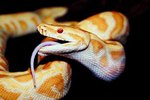
All organisms need adequate heat for normal cellular activity and essential biological processes, including digestion, excretion of waste, breathing, reproduction and circulation. Animals use various strategies to acquire and maintain heat. Snakes and lizards, classified as ectotherms, obtain heat from the environment. Endotherms, on the other hand, produce their own heat internally.
Temperature Regulation in Ectotherms
In addition to snakes and lizards, other reptiles are ectothermic, including turtles and crocodiles. Ectothermic classes include amphibians -- frogs, toads, salamanders -- and most fish and invertebrates. These animals regulate body temperature behaviorally. One strategy snakes and lizards use to acquire heat is sunning. They find a sunny spot to bask in and absorb heat from the sun. Warm rocks or other surfaces also provide heat. They cool down by burrowing, exposing themselves to the wind or finding shade. In addition, in cold temperatures, snakes and lizards practice a type of hibernation called brumation, in which metabolism slows down significantly.
Temperature Regulation in Endotherms
Most mammals and birds are endotherms, meaning they regulate their own body temperatures internally. They use energy from food to obtain heat and run cellular activities. Other strategies help in extreme conditions; the mechanism of shivering generates warmth, for instance. Some endotherms are equipped with isulation in the form of fur, feathers or blubber. To cool down, mammals sweat or pant. Hibernation is another strategy some mammals use to conserve heat in winter by slowing down metabolic processes.
Advantages and Disadvantages
Compared with endotherms, lizards and snakes need less food for their energy and metabolic processes. They don’t need to eat as often, and a greater proportion of food contributes to growth. On the other hand, they cannot survive in very cold climates and are limited in their habitats. They are vulnerable to predation when basking in the sun and cannot chase prey quickly or for an extended period of time, as they run out of energy.
In the Terrarium
If you’re keeping a snake or lizard as a pet, providing the right temperature is crucial, as these animals cannot heat themselves. Make sure you know the natural habitat, temperature and lighting conditions for your particular species. Both a primary and secondary heat source are required to mimic the natural environment’s temperature gradient. A primary source of heat such as a series of incandescent lights is a good strategy. Turn these off at night and provide another heat source, such as a heating pad under the cage. Use secondary heat sources that generate specific temperatures in specific areas of the habitat. In addition to heat, proper lighting includes a source of UV light such as fluorescent full-spectrum bulbs.
References
Photo Credits
-
Jupiterimages/Photos.com/Getty Images
Writer Bio
Leslie Darling has been a writer since 2003, writing regularly for "Mississippi Magazine" and "South Mississippi Living," specializing in food and wine, animals and pets, and all things Southern. She is a graduate of the University of New Orleans.




